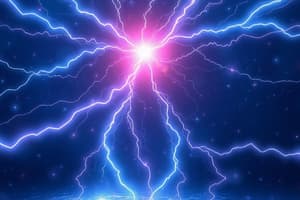Podcast
Questions and Answers
What is the electric potential defined as?
What is the electric potential defined as?
- Amount of work energy needed per unit of electric charge to move the charge in an electric field (correct)
- Amount of electric charge per unit of work energy in an electric field
- Amount of electric field per unit charge in an electric field
- Amount of kinetic energy acquired by a test charge in an electric field
In classical electrostatics, how is the electrostatic field expressed?
In classical electrostatics, how is the electrostatic field expressed?
- As the divergence of the electrostatic potential
- As the gradient of the electrostatic potential (correct)
- As the curl of the electrostatic potential
- As the Laplacian of the electrostatic potential
What is the electric potential at the reference point?
What is the electric potential at the reference point?
- Dependent on the type of electric field
- Infinite units
- Constantly changing
- Zero units (correct)
What is the reference point for electric potential typically?
What is the reference point for electric potential typically?
What is the electric potential energy of any charge denoted by?
What is the electric potential energy of any charge denoted by?
What is electric potential defined as?
What is electric potential defined as?
What is the electric potential at the reference point?
What is the electric potential at the reference point?
What does the electric potential energy of any charge represent?
What does the electric potential energy of any charge represent?
What is the reference point for electric potential typically?
What is the reference point for electric potential typically?
In classical electrostatics, how is the electrostatic field related to the electrostatic potential?
In classical electrostatics, how is the electrostatic field related to the electrostatic potential?
What branch of physics studies the behavior and properties of light?
What branch of physics studies the behavior and properties of light?
Which model of light treats light as a collection of rays that travel in straight lines and bend when they pass through or reflect from surfaces?
Which model of light treats light as a collection of rays that travel in straight lines and bend when they pass through or reflect from surfaces?
What type of electromagnetic radiation exhibits similar properties to light?
What type of electromagnetic radiation exhibits similar properties to light?
Which model of light includes wave effects such as diffraction and interference?
Which model of light includes wave effects such as diffraction and interference?
What forms the most common basis for practical optics?
What forms the most common basis for practical optics?
Flashcards are hidden until you start studying
Study Notes
Electric Potential and Electrostatics
- Electric potential is the work done per unit charge in bringing a positive test charge from infinity to a point in an electric field.
- Electrostatic field in classical electrostatics is expressed as the negative gradient of the electrostatic potential.
- The electric potential at the reference point is defined as zero, typically chosen at an infinitely far distance from the charge.
- The reference point for electric potential is generally set at infinity, where the influence of electric fields diminishes.
Electric Potential Energy
- The electric potential energy (U) of any charge is denoted by U = qV, where q is the charge and V is the electric potential.
- Electric potential energy represents the work done to assemble a charge configuration against electric forces.
Relationship Between Electric Potential and Field
- In classical electrostatics, the electrostatic field (E) is related to the electrostatic potential (V) by the equation E = -∇V, indicating that the field points in the direction of the greatest decrease of potential.
Optics and Light Behavior
- The branch of physics that studies the behavior and properties of light is called optics.
- The ray model of light treats light as a collection of rays that travel in straight lines and bend when they encounter surfaces (reflection and refraction).
- Electromagnetic radiation that shares similar properties with light includes infrared, ultraviolet, and radio waves.
- The wave model of light incorporates effects such as diffraction and interference, highlighting its wave-like characteristics.
- The most common basis for practical optics is the ray model, used in lenses, mirrors, and optical instruments.
Studying That Suits You
Use AI to generate personalized quizzes and flashcards to suit your learning preferences.




